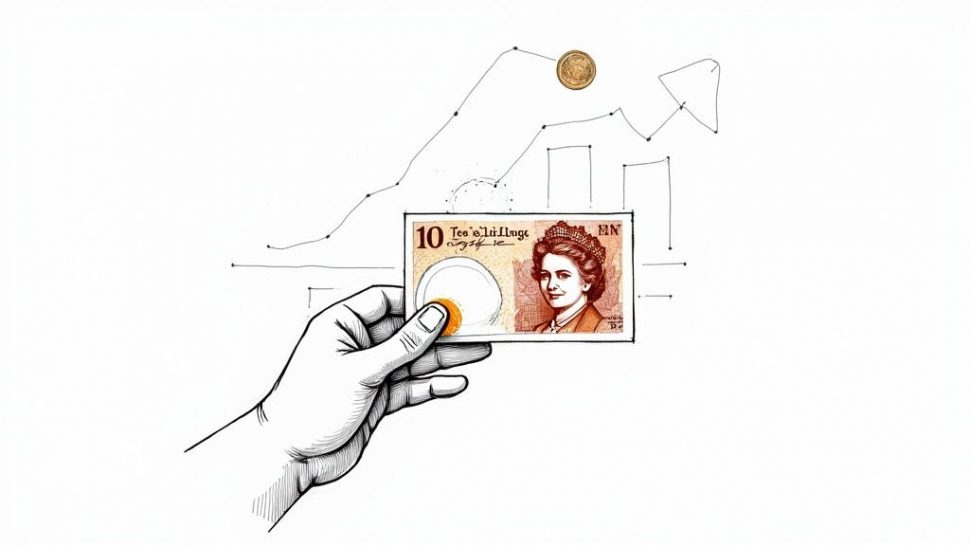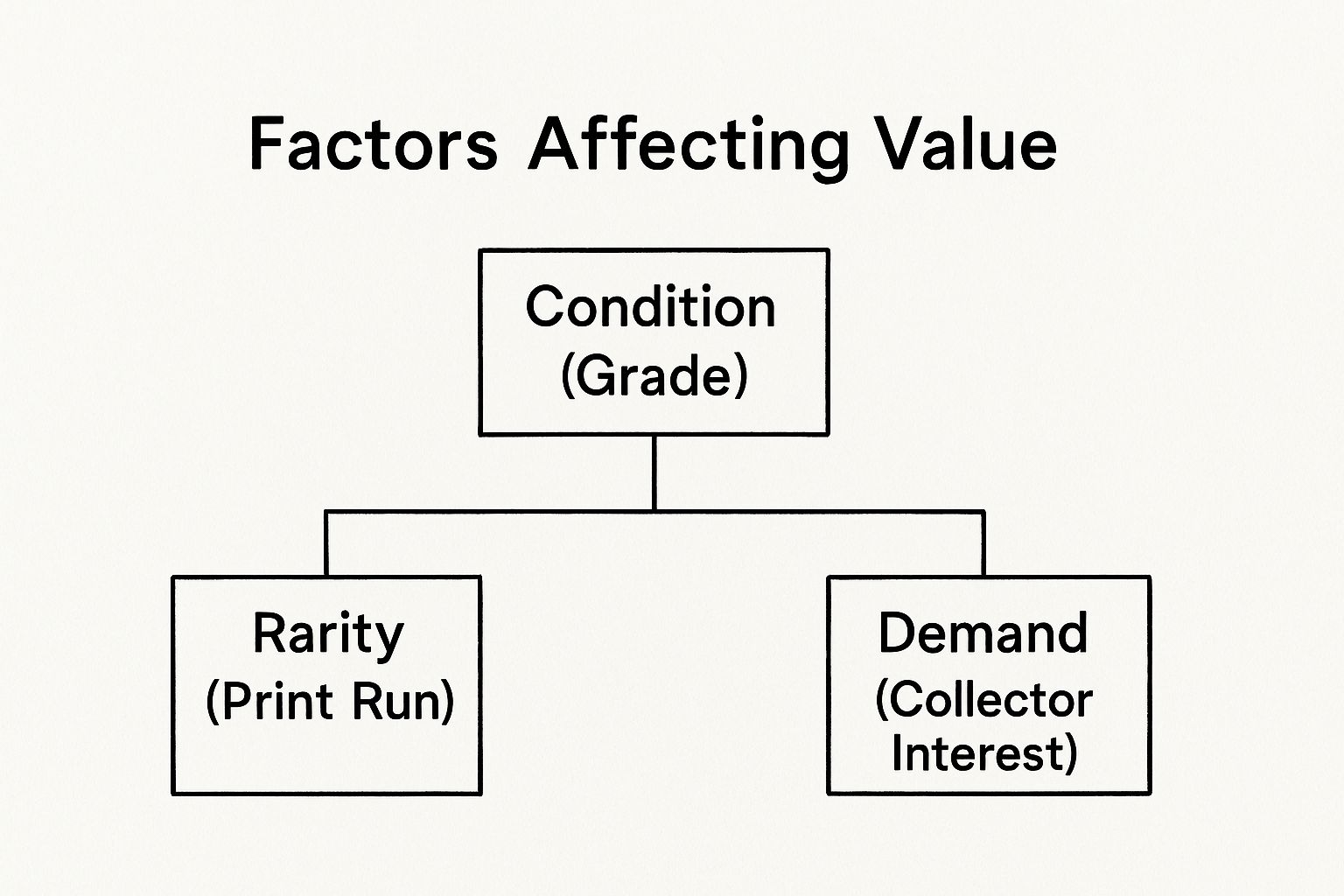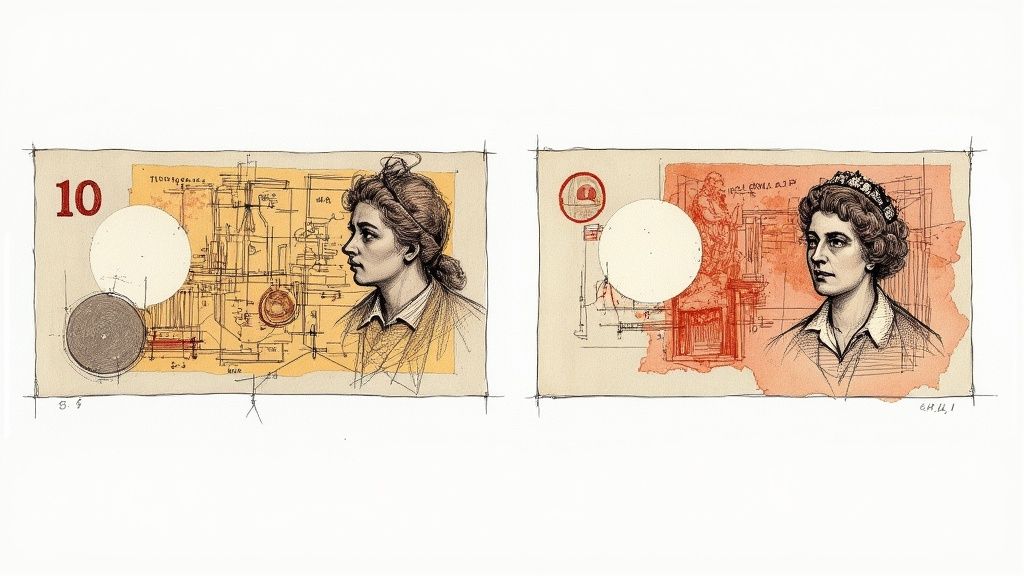How Much Is a Ten Shilling Note Worth Today?

Posted by: Ian • 30 Sep 2025
So, you’ve stumbled upon an old ten shilling note. Before you get too excited, let's get one thing straight: its value today has nothing to do with its old face value of 50p. Instead, its real worth is all about its condition, rarity, and how much a collector is willing to pay for it. A common, well-circulated 'ten bob note' might only fetch a few pounds, but a flawless one from a rare print run? That could be worth over £100.
What Is a Ten Shilling Note Actually Worth
If you've found an old ten shilling note, you're holding a genuine piece of British history. While it was equivalent to 50p when decimalisation came along, its true value now is set by the world of numismatics—the study and collection of currency. This means its worth isn't tied to what it could buy back in the day, but what a collector wants to pay for it now.
Think of it like an old piece of furniture. A mass-produced chair from the 1960s probably isn't worth much. But a rare, perfectly preserved designer piece from that same era could be incredibly valuable. The exact same principle applies to your 'ten bob note'.
From Pocket Change to Collector's Item
So, what separates a common note from a valuable treasure? A few key things come into play:
- Condition: Is it crisp and clean, or folded and worn? An uncirculated note with no creases or marks is always far more desirable.
- Rarity: Early print runs, unusual serial numbers, or notes with printing errors are much harder to find, which naturally drives up their price.
- Date and Signature: Certain notes signed by specific Bank of England Chief Cashiers are rarer than others and are highly sought-after by collectors.
The crucial takeaway is that every note has its own unique story and, therefore, its own unique value. A quick glance might not be enough to tell if you have a common keepsake or a valuable find.
To help you get a better idea, here's a quick cheat sheet.
Quick Guide to Your Ten Shilling Note's Value
This table gives a quick overview of the key factors that determine whether your note is a common find or a rare treasure.
| Factor | Low Value Indicator (Common Note) | High Value Indicator (Rare Note) |
|---|---|---|
| Condition | Heavily folded, torn, stained, or faded. | Crisp, no folds, sharp corners, bright colours. |
| Serial Number | A standard, high-number prefix. | A very early prefix (e.g., A01), a replacement note (e.g., M), or a special pattern. |
| Chief Cashier | Signed by a common Chief Cashier (e.g., J.S. Fforde). | Signed by a rarer Chief Cashier (e.g., P.S. Beale). |
| Print Errors | No visible errors. | Misaligned prints, incorrect colours, or missing ink. |
Ultimately, the best way to know for sure is to have an expert take a look.
For anyone who's found old banknotes or has leftover foreign currency from holidays, figuring out what to do next can be confusing. That’s where we come in. We offer a fast, easy, and hassle-free service to exchange foreign coins and notes.
With our 100% guaranteed process, you don't need to spend hours sorting through your collection or trying to identify rare items yourself. Trusted by major brands including charities, supermarkets, airports, and police forces, we make it simple to convert foreign coins and banknotes into cash. Ready to find out what your old currency is worth? Start your fast and easy exchange at We Buy All Currency.
The Story of the Famous Ten Bob Note

To really get a feel for what a ten shilling note is worth today, you have to rewind the clock. This isn’t just old money; the ‘ten bob note’ is a little piece of British history you can hold in your hand, and its story is exactly why it’s become such a collector's item.
Its journey didn't start in a boardroom but in the chaos of war. The very first ten shilling notes were an emergency measure, rushed out by the Treasury in August 1914. With World War I breaking out, the government had to move fast to keep the economy stable and stop people from making a run on the banks.
At the time, the smallest banknote issued by the Bank of England was £5—a small fortune for the average person. The ten shilling note was introduced to keep everyday life ticking over, making sure people could still buy their groceries and pay their way.
From Emergency Money to an Everyday Staple
After the war, the Bank of England took over printing the notes in 1928, and they quickly became a fixture in wallets and purses up and down the country. For decades, the ten bob note was a real workhorse of the British economy. In its prime, it had some serious buying power; you could get ten loaves of bread or a cinema ticket with plenty of change left over.
This historical context is what really matters. The ten shilling note wasn't just cash; it was woven into the fabric of daily life, seeing the country through everything from post-war recovery to the swinging sixties.
This long and eventful life is precisely why it holds so much nostalgic and historical value today. Each design tells its own story, from the early brown Treasury notes to the final version featuring a young Queen Elizabeth II. You can take a closer look at specific designs, like the classic Bank of England 10 Shillings banknote with the HM Queen portrait from 1961.
When it was finally replaced by the 50p coin in 1969, it truly was the end of an era. That’s why its value today has nothing to do with its old 50p face value and everything to do with its place in history.
And if you happen to find one of these treasures tucked away, perhaps with some leftover holiday money or other obsolete currency, we can help you unlock its value. Our service offers a fast, easy, and hassle-free way to exchange foreign coins and notes. It's a 100% guaranteed service trusted by major organisations like charities, airports, and police forces—with no need to sort anything yourself.
How to Identify a Valuable Ten Shilling Note
So, you’ve got a ten shilling note in your hand. Is it just an old piece of paper worth a few quid, or could it be a rare treasure? Telling the difference comes down to the small details. Think of it like being a detective—every little feature tells a piece of the note’s story and adds (or subtracts) from its value.
The first thing any collector will look at is its condition. A crisp, uncirculated note that looks like it just rolled off the printer will always be worth far more than one that’s been folded, stained, or torn. Even tiny creases can knock the value down, as serious collectors are hunting for perfection. A note that’s been kept in pristine condition is a rare survivor, and its price will reflect that.
Next up is rarity, which is often tied to the serial number. Just like a limited-edition art print, notes from the very first print runs are highly sought after. Look for prefixes like ‘A01’. Some notes were also printed as 'replacements' (often marked with a specific letter like ‘M’) to take the place of misprinted ones, which makes them much harder to find and, therefore, more valuable.
Decoding the Details
Beyond the general state of the note, two other elements are crucial for figuring out what your ten shilling note is really worth. These are the details that separate the everyday finds from the truly collectable pieces.
The Chief Cashier's signature is a brilliant clue to the note's age and rarity. Different Chief Cashiers served at different times, and some had much shorter tenures than others. A note signed by a cashier who was in the role for a short period, like P.S. Beale, means fewer notes with his signature were printed. That makes them more valuable than one signed by a more common cashier like J.S. Fforde.
Finally, take a look at the print date and design. Ten shilling notes were around for over 50 years, and they changed a lot in that time. The earliest Treasury issues from the First World War look very different from the later Bank of England designs featuring Queen Elizabeth II. Certain series are much scarcer than others, and knowing which is which is just as important for these notes as it is when determining the value of old £5 pound notes.

As you can see, the note's physical condition and rarity are the biggest drivers of its base value. But it's the demand from other collectors that ultimately sets the final price.
While this gives you a good idea of what to look for, getting a precise valuation can be tricky on your own. For a fast, easy, and hassle-free assessment, we’re here to help. We are trusted by major brands, including charities, supermarkets, airports, and police forces, to exchange foreign coins and notes. With our 100% guaranteed process, there’s no need to sort through your leftover foreign currency or obsolete money. Just send it to us, and we'll handle the rest, making sure you get the best possible value.
Why the Ten Bob Note Disappeared

The beloved ‘ten bob note’ wasn't just phased out on a whim; its disappearance was a practical response to a changing British economy. By the 1960s, rising inflation meant the humble paper note was taking a real beating in everyday circulation. It simply wasn’t built to last, and the cost of constantly printing replacements for worn-out notes was becoming a real headache.
A tougher, more cost-effective solution was needed. That solution arrived in 1969 in the shape of the world’s first seven-sided coin: the iconic 50 pence piece, introduced specifically to take over from its paper predecessor. This move was a huge shift in British currency, paving the way for decimalisation and a whole new era of money.
The Official End of an Era
While the change wasn't overnight, the ten shilling note's days were numbered. The banknote officially ceased to be legal tender on 22 November 1970, cementing its place in the history books. This decision marked the end of paper money worth less than £1 in Britain, a move driven entirely by the economic realities of the time. You can discover more about this fascinating transition from the ten bob note to the 50p coin.
This shift from paper to coin is exactly why your ten shilling note is now considered obsolete currency. You can’t pop to the shops with it, but it absolutely still holds value—not just for collectors, but for anyone looking to exchange it.
This is where finding a simple, no-fuss exchange service is key. Whether you have ten shilling notes, a drawer full of leftover foreign currency, or want to donate foreign coins to charity, the right partner makes all the difference.
Our 100% guaranteed service, trusted by major brands like charities, supermarkets, airports, and police forces, makes the whole process easy. You don’t even need to sort your currency; just send it to us and we'll handle the rest.
How to Exchange Your Ten Shilling Note and Other Old Currency
So, you've got an old ten shilling note and you're ready to turn it back into cash. What's the best way to do it?
You could try your luck with specialist dealers or go directly to the Bank of England, but honestly, those routes can be slow and often more hassle than they're worth. If you want to see what the official process involves, our guide on the Bank of England old notes exchange lays out all the steps and limitations.
We offer a much more straightforward path. Our whole service is built to be fast, easy, and completely hassle-free. We provide a 100% guaranteed exchange for all your obsolete currency, taking the guesswork out of it for you.
A Simple Solution for All Your Old Money
The real beauty of our service is that it isn't just for that one ten shilling note. Have a drawer full of leftover holiday money? A jar of forgotten foreign coins? Or maybe some other old British cash? We take it all. There’s no need for you to sort through everything, try to identify dates, or figure out what might be valuable.
Our promise is simple: you send it, we sort it. It’s this no-fuss approach that has made us a trusted partner for major UK brands, including charities, supermarkets, airports, and even police forces. We handle all the details so you get fair value without the headache.
It’s one thing to understand the value of a specific note, but getting a feel for the bigger picture, like how to get local currency for your travels, shows just how complicated money exchange can be. We simplify that world by turning your old, unused currency back into money you can actually spend.
We specialise in making it easy to exchange foreign coins and notes. Whether you want to convert foreign coins and banknotes for yourself or donate foreign coins to charity, our process is the most convenient way to unlock the value in your old money.
Comparing Your Currency Exchange Options
See how different exchange methods stack up and why a specialist service offers the most convenience for all types of old currency.
| Feature | We Buy All Currency | Specialist Dealers | Bank of England (Limited) |
|---|---|---|---|
| Coins Accepted? | Yes, all types | Sometimes, but rarely | No |
| Foreign Currency? | Yes, from all over | Some, depends on dealer | No |
| Obsolete Notes? | Yes, all of them | Selective | Only certain notes |
| Process Speed | Fast, streamlined | Can be very slow | Long waiting times |
| Convenience | High – just send it all | Low – requires research | Low – requires forms/visits |
When you look at it side-by-side, it's clear that for a simple, all-in-one solution, a dedicated service like ours is the most practical choice.
Ready to turn that forgotten currency into cash? Visit our homepage to start your fast and easy exchange today.
Questions We Hear All The Time About Ten Shilling Notes
When you're dealing with old currency, a lot of questions can pop up. We've put together the most common ones we get about the old 'ten bob note' to give you the clear, simple answers you're looking for.
Can I Still Use a Ten Shilling Note in a Shop?
In short, no. The ten shilling note was officially taken out of circulation and stopped being legal tender way back on 22 November 1970. So, while you can't spend it at the corner shop, it absolutely still has real monetary value to collectors.
That's where a specialist service like ours comes in. Our service is a fast and easy way to exchange it, turning that bit of history into modern cash.
How Can I Quickly Tell If My Note Is Rare?
A quick glance can give you a few clues. You'll want to look for the earliest dates, very low serial numbers, or signatures from some of the less common Chief Cashiers like P.S. Beale or K.O. Peppiatt.
But honestly, the easiest and most reliable way to know for sure is to let an expert take a look. Our fast, hassle-free service takes all the guesswork out of it and gives you a 100% guaranteed, accurate value.
What Other Old Currency Can I Exchange?
We exchange all sorts of old currency, not just from the UK but from all over the world. Maybe you have a jar of old British coins, leftover foreign currency from a holiday years ago, or other obsolete banknotes you’ve found.
The best part of our service is that there's no need for you to sort through any of it. Just send it all to us, and we provide a 100% guaranteed exchange for the lot. It's a hassle-free solution for all your leftover coins and notes.
Is It Worth Getting My Note Professionally Graded?
For the vast majority of ten shilling notes, spending money on professional grading just isn't worth it—the cost of the service would likely be more than the note's final value.
Our trusted exchange service is a much simpler, fast, and easy way to unlock its value without the extra expense and hassle.
At We Buy All Currency, we make it fast and easy to convert foreign coins and banknotes. Our process is trusted by major brands, including charities, supermarkets, airports, and police forces. For a hassle-free, 100% guaranteed way to exchange your leftover foreign currency, obsolete notes, or even donate foreign coins to charity, we provide the perfect solution. Visit We Buy All Currency to start your exchange today
